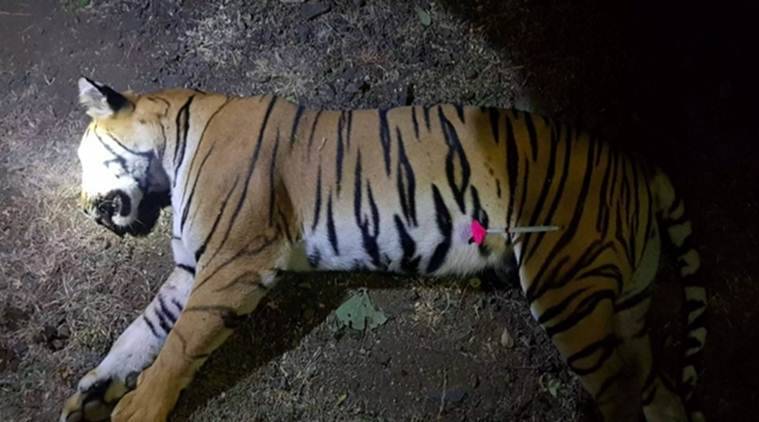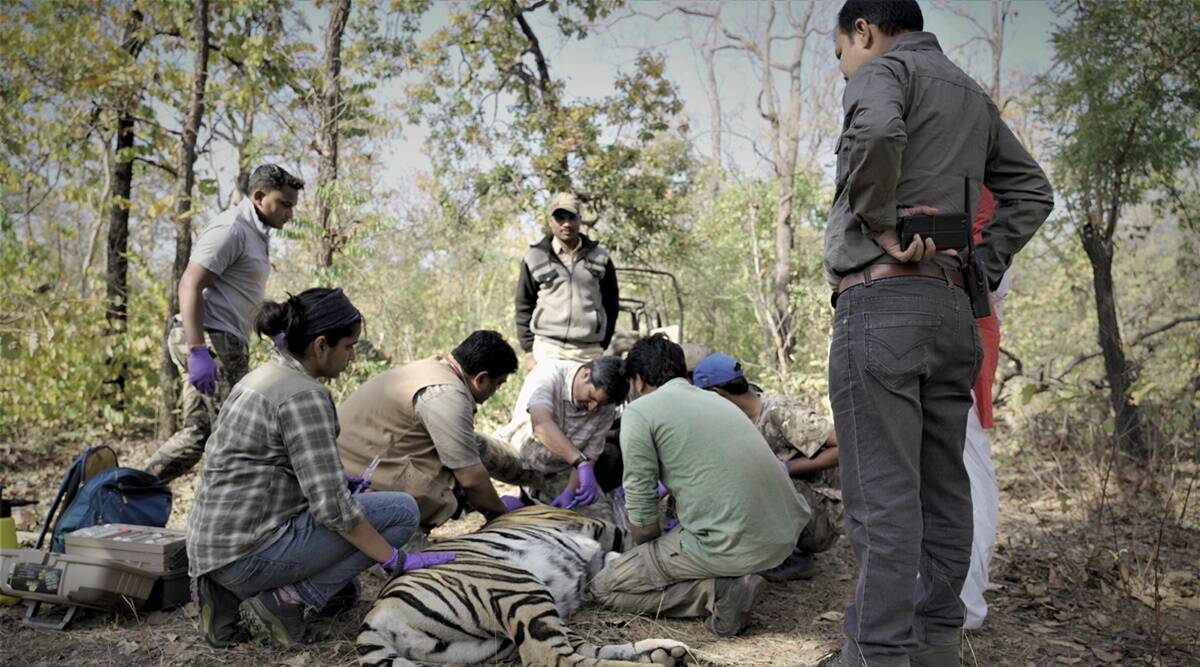Why do more tigresses than tigers come into conflict with humans? How did a tiger travel for 3,000 km evading human contact? Tiger-tracking has helped answer these questions and more in Maharashtra.
The Vidya Balan-starred ‘Sherni’ has generated a lot of interest about the complex relationship between man and tiger. Inspired by the Avni saga of 2018, when the tigress Avni was shot dead in the forest of Pandharkawada in Yavatmal district of Maharashtra, the film shows in bits and pieces how the forest department tracked a tigress that had begun attacking humans, and was believed to have killed at least five people before being ordered captured or shot dead.
In Maharashtra like in the movie, Avni’s story ended with its controversial killing by a private shooter hired by the forest department. In Maharashtra like in the movie, Avni’s tracking tested the limits of the department’s skills.
So how exactly is a tiger tracked, and why?
Given the tiger’s superlative ability to hide when under the scanner, the importance of tiger tracking — not only for capture operations but also for understanding its overall behavior and ecology — can’t be overstated.
Over the years, tiger tracking has improved tremendously, thanks to refined technological tools available to wildlife managers. It has led to better understanding about the world of the tigers as a whole, throwing up immense possibilities of better tiger conservation.
Two major ways of tracking a tiger include camera traps, as was shown in ‘Sherni’, and radio collars. GSM camera traps can also be used, though they are dependent on internet connectivity.
Radio collars are put on tigers for long-term studies of their behaviour, their feeding and movement patterns, etc. For this, a tiger is tranquilised and the collar put around its neck. Using the highly sophisticated technology of radio telemetry, officials can get real-time information about its movement.
How camera traps help track a tiger
However, if a non-collared tiger has to be captured, wildlife managers have to depend on the traditional methods of following pugmarks, tiger scats, scratch marks on trees, and camera traps. This means officials are essentially playing catch-up with the big cat.
The camera traps are laid at locations which the tiger is most likely to move past. But apart from these places, it keeps moving to scores of other areas where there are no cameras. Thus, only a few locations of the tiger can be received. Further, the cameras are checked only after a gap of 2-12 hours, depending on the circumstances. By the time its images are found in a given camera trap, the tiger has already moved to a different location, giving the officials only an approximate idea about the areas where chances of finding it are bright. But that again hinges a lot on the luck factor.
Also, while camera traps do help in identifying the animal, but if more than one tiger is moving around in a given location, this can get tricky.
This fact is borne out by two prominent examples — the exhaustive operations to capture both Avni (2018) and RT1 (2020), a tiger from Rajura tahsil of Chandrapur district in Maharashtra that had killed about nine persons over a period of about 18 months.
What telemetry tracking has revealed about tigers
In telemetry tracking, the tiger always remains on the officials’ radar.
But more than the exact route of tiger movement, telemetry also gives a great insight into tiger behavior. It gives valuable information about when it walks, where it prefers to halt, for how long does it rest, what does it kill, how frequently it kills, etc.
When the tiger moves through human-dominated landscapes, it generally moves with predictable directionality, meaning it takes a particular route and continues on it unless disturbed. In the forest, however, it doesn’t follow any particular direction, since it has a proper habitat all around to feel at home.
Tiger tracking is done both in protected areas (PAs) and non-PAs (generally human-dominated landscapes). This is further distinguished into tracking in established and non-established territories. Generally, tigresses have small territories, which they fiercely guard by continuously patrolling it. Tigers, on the other hand, have big territories and hence when they move from one end to the other, another male could trespass into their territory and they wouldn’t even notice.
But there are also tigers that do not have established territories. Such tigers can be found in both PAs and non-PAs. The movement of such tigers is unpredictable and difficult to track. With time, they learn the art of avoiding humans and conceal their movement as they walk through human-dominated landscapes or through the territories of other tigers.
The Maharashtra forest department has implemented a special tiger tracking programme in association with Wildlife Institute of India (WII), called Dispersal of Tigers in Eastern Vidarbha Landscape from 2016 to 20. Its mandate was to study patterns of tiger migration. The study threw up many interesting facets of tiger migration.
The story of Walker, who walked 3,000 km
The most significant of the tigers studied was Walker, whose over 3,000-km epic journey from Pandharkawada in Yavatmal district to Ajanta caves in Aurangabad district in six months raised eyebrows.
The most valuable input from Walker’s tracking was that it instinctively and successfully avoided contact with humans. The only instance of conflict during its journey occurred in Nanded district, where the fault lay with humans, who had tried to get close to it while Walker was resting in the forest. The group of men got away with minor bruises before Walker preferred to proceed on its journey.
This sequence was evidenced by telemetry tracking. In the absence of it, officials would have had to invest a lot of time and money to contain the conflict, since they wouldn’t know that the tiger had moved on.
Tracking of a tiger nicknamed Gabbar in the Tadoba Andhari Tiger Reserve (TATR) also provided valuable information about tiger behaviour.
Gabbar was injured in a territorial clash with another tiger. There was a debate whether an intervention should be made to treat it. But it was avoided, and Gabbar got well on its own. But during the injury, it exhibited a different pattern of movement. It moved during afternoons to avoid contact with other tigers, as against the normal tiger movement timings of early morning and evening.
Why do more tigresses than tigers come in conflict with humans?
Wildlife managers received another very important information from this special monitoring programme. It was found that a tigress needed more food than a tiger during comparable time periods. This is because the tigress has a much smaller territory to defend. So it more vigorously moves up and down the area, spending more energy and thus requiring more food. This is also true when the tigress is not breeding. It was found that females in PAs require 10-12 per cent more food than males.
This was also established as the main reason why an overwhelmingly large proportion of females generally come in conflict with humans. The food requirement of females over males goes up by about 24 per cent in human dominated landscapes.
The programme also tracked a tigress’s dispersal from TATR to Umred-Karhandla-Paoni Sanctuary in Nagpur district. That tigresses generally don’t move long distances is a known fact, but the TATR tigress’ dispersal of over 150 km confirmed that they do move long distances when there is a connecting and safe corridor.
But perhaps the most valuable of all information that tiger-tracking provides is the safe corridors that the big cats choose to migrate. This has far-reaching implications for tiger conservation, since facilitating migration is crucial to not only to reduce the overload of tiger density in a few areas, but also prevent in-breeding and ensure genetic variety. Tiger tracking helps identify such corridors that wildlife managers need to fortify, to encourage the tigers to migrate to other areas.
The Forest Department and WII are now planning another long-term research programme on tiger monitoring and dispersal in Maharashtra, which would entail radio collaring of a tiger family’s three-four generations. The special feature of this programme would be that it would also cover cubs.
(Based on inputs provided by senior WII scientist Bilal Habib, who is leading the tiger monitoring programme in Maharashtra and has an experience of monitoring of over 30 radio-collared tigers across India)
Source: Read Full Article



